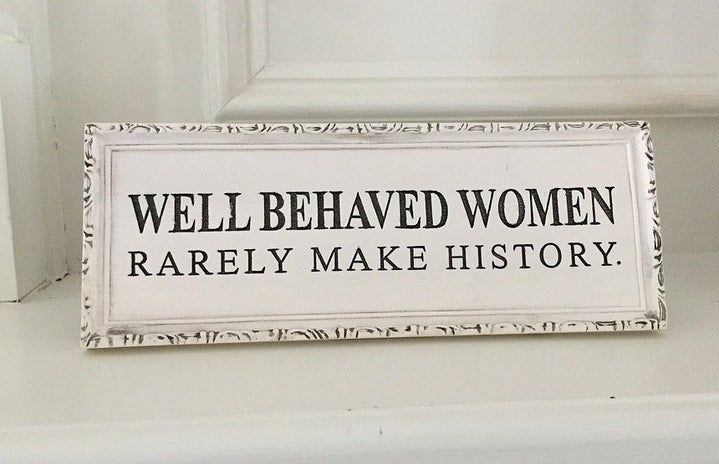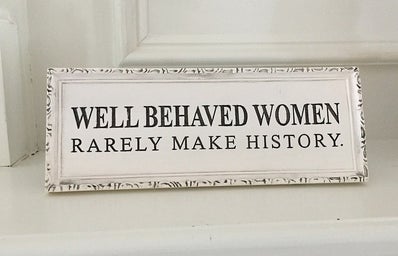It’s no secret that there has been countless inspirational, powerful and important women throughout history! The only problem is, how am I supposed to keep track of them all? Well the National Women’s Hall of Fame is here to help with this problem. There are currently 302 inductees included in the museum and they are always open to nominations for new inductees.
This hall of fame continuously upholds their mission of “showcasing great women … inspiring all!” This museum is a much needed organization, as it complies a variety of great women in history. There is a total of eight categories representing the type of achievements a woman has earned. Located in Seneca Falls, New York, “the Hall stands as a home for those who took it upon themselves to fight for a place in history.” Before I heard about the National Women’s Hall of Fame, I always wanted to visit Seneca Falls, New York, seeing as it is the birthplace of women’s rights. But, now, I have even more reason to visit the city!
It is entirely impossible to pick even a top 10 of the women in the Hall I find most inspiring. However, I am going to attempt to pick a few to help demonstrate just how much of a variety of women the museum features. When it comes to the women included in this list, I recommend giving each one’s full bio a read, as I am unable to cover everything in one short paragraph.
Make sure to check out even more inspirational women in their full collection.
*This list is in no way meant to denote importance to select women in the Hall. Each and every woman (including non-inducted women) have made unrankable contributions to history!
Joy Harjo
When it comes to art, Joy Harjo is an artist five times over. She has done a variety of work as a painter, musician, author, playwright and poet. Generally she uses her art as a form of activism centering around feminist, First Nations history and storytelling, indigenous, environmental and social justice themes. As the 23rd United States Poet Laureate, Harjo became the first Native American to be given this honor. In her 2019 – 2021 Poet Laureate term, she created “Living Nations, Living Words” which is a digital map of a variety of works from contemporary Native poets.
Lucille Ball
You may know Lucille Ball as the star of “I Love Lucy,” but that is just one of her many artistic achievements. In the 20 years leading up to her sit-com series, Ball starred in over 75 films. Her and her husband launched “I Love Lucy,” in which it was based on their own life. They used many never-before-seen technics in the production of the series. If those “firsts” weren’t enough, she was the first woman to be visibly pregnant on television. She also became a Hollywood studio head — making her the first female to hold such a position.
Billie Jean King
From the early age of 11, after only a few lessons in tennis, Billie Jean King told her mother, “I’m going to be number one in the world!” This statement was not an empty promise, as she did in fact earn this title five times between the years of 1966 and 1972. Through King’s life, she made major contributions to the world of women’s tennis. In 1973, by defeating Bobby Riggs, Billie Jean King proved that skill is not a matter of gender. Her hard work and dedication lead to women’s tennis becoming a professional sport.
Aimée Mullins
Since she was a year old, Aimée Mullins has been breaking barriers. Due to her double leg amputation, Mullins had to do a lot of adjusting in her live to succeed. Her main sport has been track, but that didn’t stop her from excelling in other sports and areas of life. She is also a model and actress and is consistently trying to highlight her protheses rather than detract from them. In addition to the barriers she broke, Mullins has also broken multiple world records in track and field. Unrelated to her accomplishments in track, at just 17 years old, she received top-secret security clearance at the Pentagon. She continues to overcome adversity and advocate in all aspects of her life.
Lydia Moss Bradley
I may not experience firsthand the inspirational effects of all these women in my day-to-day life, but I am still able to recognize their achievements. However, as a student at Bradley University, Lydia Moss Bradley’s work does in fact affect my day-to-day life. And let me tell you, she was a total badass. In 1896, she founded an academic institution that, in 1920, would become known as Bradley University. Her life was filled with a variety of achievements and “firsts.” She was the first female board member in the United States to serve on a national bank board. One of her other “firsts” acknowledges her behind the scenes work towards establishing Illinois’s first park system. She pressured the city fathers of Peoria, Illinois to create such a system, and her passion didn’t stop there, she even donated the land needed for this venture. She is also responsible for giving the Society of St. Francis a large estate in Peoria, Illinois. This estate was intended for a hospital and would become known as OSF St. Francis Medical Center. In downstate Illinois, this has become one of the largest medical facilities.
Linda G. Alvarado
In a world full of supposedly “male-only” professions, Linda G. Alvarado flipped that stereotype on its head. She founded and is the sole owner of Alvarado Construction in Denver, Colorado. Whether construction site harassment, or inability to receive a business loan, Alvarado persevered and created one of the most successful and highly respected construction firms in the country. She also became the first Latino to own a Major League Baseball team — the Colorado Rockies. She was even the first woman to partake in an ownership bid for a major league franchise.
Eleanor K. Baum
Imagine being the only woman in your major’s program at your university — sounds lonely, right? Well, Eleanor K. Baum didn’t have to imagine because she was the only woman in the 1959 engineering class at City College of New York. From there, her career in engineering was full of “firsts.” She was not only a chairperson of the electrical engineering department at Pratt Institute, but she would later become the first ever female to be named dean of an engineering college. On top of these achievements, she became the first female president of the American Society for Engineering Education.
Susan B. Anthony
As one of the founding mothers of the women’s rights movement, Susan B. Anthony spent almost her entire life fighting for women’s rights. She joined forces with Elizabeth Cady Stanton and together they pioneered the path for women’s suffrage. As a form of protest, Anthony took to the ballot box and illegally voted. Because of this action she was tired, convicted and fined. Unfortunately, she didn’t live to see the ratification of the 19th Amendment. She knew this fight for equality would be difficult and lengthy, so as she addressed her final women’s suffrage conference she said, “Failure is impossible!” This was in hopes of keeping the movement alive even after she died. And it was 14 years after her death — and a century after her birth — that the 19th Amendment was ratified and granted women the right to vote.
Bessie Coleman
We hear people say, “the sky’s the limit” all the time as a way of encouraging people to follow their dreams. Bessie Coleman — both literally and metaphorically — is a prime example of that motto. She found a love for aviation in her school books, but she was turned away from American aviation schools due to the color of her skin. Coleman knew aviation was what she wanted to do, so she learned French and traveled overseas to earn her international pilot’s license from a well respected school. After receiving her pilot’s license, she toured America for five years. She made quite a name for herself and used her passion for flying as a protest against segregation. Coleman had plans to open an aviation school of her own where she would teach other Black Americans. Unfortunately, her hopes and dreams came to a screeching halt due to her tragic death in 1926. During her life, Bessie Coleman was able to shatter the glass ceiling and fly her way over any form of oppression.


